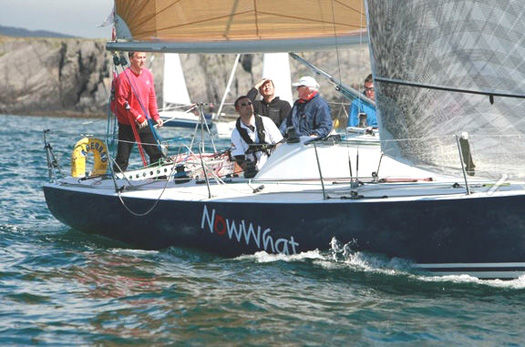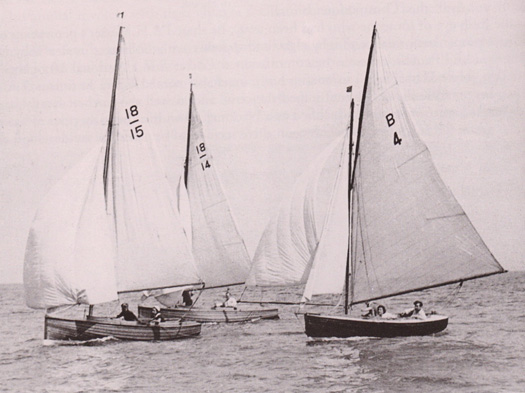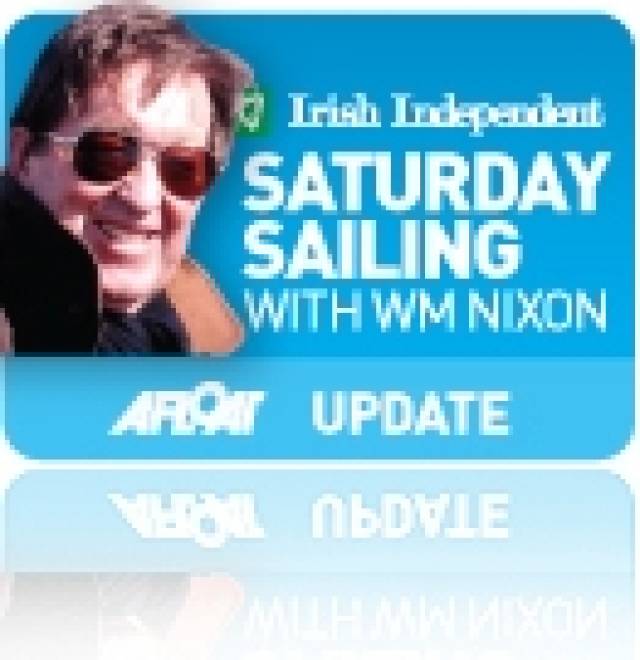#ucd – Never before have we had ten Afloat.ie/Irish Independent "Sailors of the Month" in the one month. But with Christmas approaching it's time for gifting all round, and the adjudicators have agreed the entire UCD team that clinched the Student Yachting Worlds in France four weeks ago are Sailors of the Month for November.
UCD Sailing Club Captain Cathal Leigh-Doyle made best use of the extensive resources of talent available in Ireland's largest university by taking along a squad of ten, even though the boats used are actually raced by eight.
Ever since they won the right to represent Ireland by taking the national college title in Dun Laoghaire in March, the UCD club's key officers had been keeping an intensive training programme on track. They'd also copped on to the significant fact that you're allowed to deploy substitutes, massively important when the high-scoring overnight offshore race followed immediately after a day of intense inshore contests.
With the points table at a crucial phase, sailing skipper Aidan MacLaverty and tactician Barry McCartin were able to bring on board the fresh energy of the highly experienced Ben Fusco and Ellen Cahill for the marathon overnight contest, and this made for the key contribution to the massive points lead with which the Irish team clinched the world title.
The complete team were Cathal Leigh-Doyle, Aidan McLaverty, Barry McCartin, Ben Fusco, Ellen Cahill, Simon Doran, Bella Moorehead, Alyson Rumball, Theo Murphy and David Fitzgerald, and they did us proud.
FASTER, FASTER...
Speed is of the essence in global sailing at this time of year, with conditions at their best in the world's favoured location for those extreme extra knots, Walvis Bay in Namibia. Where everyone once dreamed of breaking the 40 knot barrier, and then the 50 knots, now we're looking at 60, and the focus is shifting from kite-sailing back to boats.
Presumably the reason is once a kite surfer get beyond, say, 55 knots, they're not really on the water at all. And anyway, without the protection of some sort of hull, speeds of this nature are highly dangerous – we're pushing towards a hundred kilometres per hour, and at those speeds the sea becomes a very unforgiving surface – you need a boat of some sort around you.
But they're not boats as we know them. When Australian inventor Paul Larsen appeared at the Weymouth Speed Week with his first SailRocket just ten years ago, he struggled to get past 30 knots, but even then his boat was off the wall, more a sail-machine than a boat. Now with SailRocket2 and perfect sailing conditions at Walvis, the veteran speedster has this week been able to claim an officially recognized record of 59.38 knots, and it is known that he has been sailing better than 65 knots.
It's all very well so long as the old engine holds together. But with the new generation of 72ft America's Cup catamarans showing how easy it is to go into widow-making cartwheels when you push the speed up to just 45 knots, these guys have clearly gone beyond being sailors – they're test pilots, and with a Kamikaze flavour too.
Certainly some seasoned observers of the America's Cup scene are seriously worried about the danger the new AC boats pose to life and limb. Most folk assume that with a capsize, you have a soft landing with so much water about. But the reality is that with the oversize dimensions of the new generation of America's Cup cats, if there are any breakages a crewman falling from the outermost part of the stern onto the wing mast can have a direct drop of 35 to 40ft, and if he lands on splintered carbon there's lethal potential for injury.
GALWAY ON THE MARCH
It looks increasingly unlikely that Galway will be a host port for the next edition of the Volvo Ocean Race, with the deadline of December 7th for making a soundly-based proposal looming up while too many issues still remain unresolved from the last time round.
Already in Galway you sense a mood of moving on, and the acclaimed honouring of NUI Galway's Reflex 38 as the ICRA Boat of the Year is a reminder that there is offshore campaigning from Galway in other areas of sailing, and it was very much there - and nationally recognised - before the Volvo circus came along.
At the presentation of the award, the boat's owner Martin Breen – a key player in the "alternative Galway" offshore racing scene – was inspired to assure everyone at the ICRA AGM that, come June, "everything that floats in Galway will be at Fenit for the ICRA Nationals".
And Nobby Reilly, the new ICRA Commodore, fondly recalled those halcyon days when the GK 34 Joggernaut, owned and campaigned out of Galway Bay SC by Donal Morrissey and his team, was a regular and successful performer in a huge variety of offshore events in Ireland and abroad.
What the rest of Ireland may not know is that the Joggernaut team syndicate is still very much in action, operating on two fronts. They have a cruising ketch, the 48ft Rebound, which is kept busy in many cruising areas, and for "a spot of sport at home", they have the Dubois 34 Nowhat, a speedy machine which was very much in the hunt when the team went forth with other Galway Boats to Calves Week in West Cork back in August.

The Joggernauts of Galway are still very much at it – seen at Schull during Calves Week 2012 racing their Dubois 34 Nowhat are (left to right) Barry Heskin, Declan Killilea, Robert McDonagh, Donal Morrissey and Declan Mahon.
NATIONAL 18s COME TO DUBLIN BAY
It was a brilliant move to invite the extraordinary National 18s out of their Crosshaven stronghold to stage their annual championship in Dun Laoghaire at the National YC in the middle of June next year. In the week after the Dun Laoghaire to Dingle Race, and with the offshore brigade in strength at Tralee Bay, the current Mitsubishi Motors "Club of the Year" would otherwise be quiet enough at the time. But everything we know about the National 18s suggests that any risk of an unseasonal easing of the sailing and social pace has now been very effectively blown away.
They're great boats, and great people sailing them. So vigorous is the class spirit in Crosshaven that back in 1994, they inspired the creation of the 1720, which was envisaged as a 26ft keeled version of the National 18. As the boom years arrived, the 1720's demand for a crew of five was difficult to meet, everyone had boats, so the SB3 (now the SB20) was created as a little sister. But with recession upon us, the quite complex SB20 has – at the very least – paused for breath. So now we've come full circle, the focus is back on the National 18 as a three man boat which can function within a manageable budget, and who knows what will come of the class putting in a gallant show in Dun Laoghaire.
Time was – as the item in this website yesterday recalled – when there was a class of National 18s at Skerries. And way back in the 1930s, there were three pioneering boats at Howth trying to inaugurate a class of large dinghies, for this was before the Mermaids started gathering strength.
But the class at Crosshaven was always in a league of its own in terms of vitality, and curiously enough their strongest National 18 links were at the other end of the Cork-Swansea ferry, where there was a thriving class at the Mumbles Sailing Club. The inter-club contests at both centres involving the Royal Munster (as it was then) and the Mumbles were epic. These days, you might be lucky enough to get some venerable and ever so respectable pillar of Cork society to unwind a little as he happily remembers those expeditions to Welsh Wales, and the return visits by the Welshmen complete with their choirs.

Howth Regatta 1939, with two of the pioneering National 18s of the Uffa Ace design racing with a similarly-sized Essex One Design which had been imported in the hope of establishing a class of large dinghies. The leading National 18 is helmed by Aideen Stokes, while Artie Corbett helms the Essex OD. Photo: W N Stokes
































































